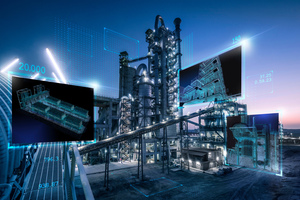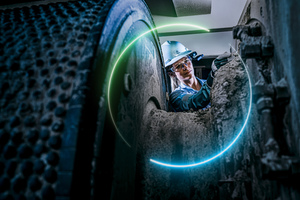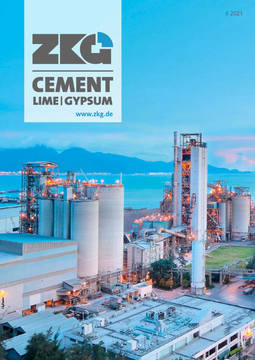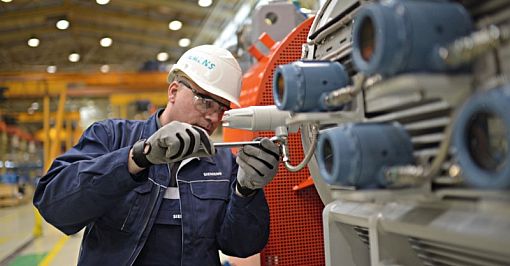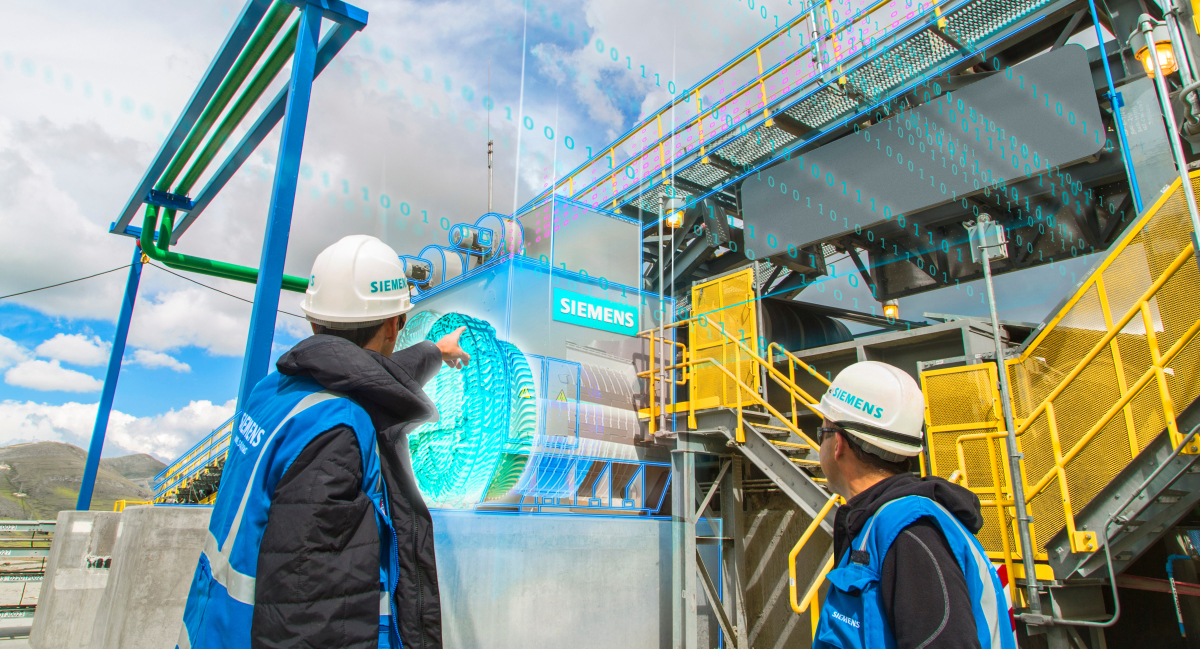How digitalization leads to greater efficiency, higher profitability and improved sustainability
Digitalization is one of today’s big buzzwords. But what does it mean in practical terms for the cement industry? Can digital tools and services contribute to enhancing efficiency, raising profitability and improving sustainability? In the interview, Dr. Justin Bisping, Head of Digitalization at thyssenkrupp Industrial Solutions AG, Business Unit Cement Technologies explains the challenges facing the cement industry in the coming years and the path thyssenkrupp is taking with its polysius® digital solutions.
We see digitalization as a vehicle to make our expertise an integral part of our products and thus offer added value to our customers. This may mean that we use digital technologies in the context of remote support to put a customer with a specific problem in touch with our experts as quickly as possible. In this case, the added value for the customer is increased plant availability. When it comes to optimizing the operation of a plant, digitalization may mean using intelligent controllers to improve throughput and energy efficiency. In this case, our expert knowledge and extensive experience are incorporated into the development of a smart controller.
thyssenkrupp Cement Technologies offers a portfolio of digital tools and services aimed at increasing the efficiency of customers’ cement plants and tackling the challenges they face, both now and in the future. In many cases remote commissioning or remote condition monitoring enable the expertise and experience of in-house specialists to be made available to customers anywhere in the world without the need of costly and time consuming travel.
Our digital solutions are backed by an unequalled wealth of experience and expertise in cement production technology. As a provider of solutions for the entire cement production process, thyssen-krupp has a holistic lead over companies offering solutions for individual process stages. In addition to this, thyssenkrupp has years of experience in digital tools and their deployment in a wide range of applications. In other words, the added value generated through polysius digital solutions comes from the unique combination of in-depth technical expertise and routine in working with the pos-sibilities and potentials of digitalization.
I see starting points in remote services to quickly connect a customer’s problem with our experts without the need of time consuming travel.
When it comes to collecting data on a big scale and making it available, this might sound trivial but it is far from it. It is not about installing additional sensors and starting recording random information. It needs to be done in a structured manner, it also requires expert knowledge of the mechanical equipment and the process. Furthermore, it really helps to have a use case for the data in mind. To give an example, if you want to remotely monitor the mechanical condition of a mill, you need to have an in-depth knowledge of that machine to specify the data collection system to be really useful. In addition, you also need a way of organizing the data, keeping it secure and making the information available. By making information available, I am not talking about just providing access to the raw data but also to aggregate the relevant information contained therein.
Both, remote services and data collection, is what we have already been doing for quite some time and where we have the experience and technologies available.
I think that for many cement producers the topic of digitalization is quite abstract. Only a few have an idea what might be possible, what are proven solutions, what solutions are still developmental.
So first of all it is important to understand the goals of a customer. With that understanding we can pick existing solution modules and also developmental features and put them together to an overall approach fitting the customer.
That is why a detailed dialog with each customer is a key precondition for proposing the best possible solution and implementation path. In case of straightforward condition monitoring needs, this does not require much work. In case of more complex process optimization goals, typical components of this process will be an evaluation of flowsheets from the plant in question, an analysis of historical data (if it exists), an inventory of the existing automation and instrumentation, and possibly an on-site audit of the plant by thyssenkrupp’s specialists. Once potentials have been identified in this way, a step-by-step plan can be drawn up.
In many cases, yes, but not in all. We have digital solutions that do not necessarily require data collection. The solutions grouped together under polysius connect, which are essentially solutions for remote support, do not necessarily require this, but it is helpful here as well.
For most use cases, however, data collection and provision is the first concrete step on the path to digitalization. We have proven solutions for this in our portfolio with our edge technology, consisting of the Local Analyze Interface – LAI and the tk cloud. Depending on the specific task, we define the data collection required for this. This can be data from existing instrumentation, i.e. in this case no additional sensor installations would be necessary, or data from sensor technology that has been installed specifically for the use case. By the way, if additional sensor technology should be required, we also take care of the installation.
Our edge technology has the flexibility required to collect information from a wide variety of data sources in one location, make it available, and compress and analyze it as needed. This is ideally carried out in the cloud, although some applications can be performed locally if this is preferred by the customer.
The next level is all about making the data useful. There is no general answer here, but instead it depends on the individual needs of the customer. Basically, it can be said that the measures are aimed at increasing our customers’ margins. These can be solutions that increase the availability of the plant, reduce unplanned downtimes, reduce the energy requirements, increase throughput, simplify problem solving – or all of the above at the same time.
In a first step, it is often very helpful if extensive quantities of data are available, are easy to retrieve and have already been pre-compacted, e.g. in the form of statistics or trends. This lets the operators develop a deeper understanding of their plant and therefore optimize its operation. In the event of problems, this allows our experts to acquire a good overview of the situation very quickly and provide targeted support. Downtimes can thus be minimized. It also saves costs by reducing the need for on-site support.
Condition monitoring can be a further step. Here we use our detailed knowledge of the machines, systems and processes and install a suitable, targeted data collection system. We summarize the information gathered in this process on a regular basis and – if necessary – have it evaluated and discussed by our experts. As a result, the customer receives not only our equipment, but also our specialist knowledge. Condition monitoring can therefore target both the process and the mechanics. Here it is also possible for us to actively alert customers to irregularities that require their attention, for example, in order to avoid incipient damage or rectify it in a planned manner so as to avoid unplanned downtimes.
Yes, it’s not just about condition monitoring. There are further opportunities! For example, I’m thinking of intelligent controllers that can optimize in real time. These may be expert systems or AI-based systems that enable more efficient operation or prevent equipment from being damaged – and thereby improve plant availability.
A further example would be intelligent production planning, which can be used to plan electricity price-optimized mill operations in the case of volatile electricity prices.
Predictive operation is a really big step for us.
Wouldn‘t it be useful to know in advance what product quality will look like? Predictive operation could make this possible.
With our polab Cal laboratory automation system, we can make a statement about product quality. In and of itself, this would not be anything new. What is new is the fact that we can do this in an automated way and at a much higher speed than conventional analytical methods allow. A comprehensive description would go beyond the scope of this interview, so I refer you to our various publications on this subject.
However, in brief, it is interesting to know that for the automated analysis we consider the reactivity of the clinker or cement samples. More precisely, we look at the first peak of the energy release, which allows us to obtain automated information about the product quality within a period of about 20 to 40 minutes. This is fast enough to use polab Cal as a source of information in an intelligent control loop. The classic compressive strength tests, the results of which are usually available after one to 28 days, are much too slow for this.
For the first time, product quality is available to us as a control variable, and the process parameters can be specifically influenced as a result.
By the way, polab Cal can of course also be used very meaningfully as a stand-alone laboratory automation system without integration into a control system.
In summary, it is actually always about increasing efficiency for the customer. In the simple case, this can be improved data transparency, which allows the customer to run their plant better, or it can allow our experts to remedy the customer’s problems quickly and inexpensively. This can be condition monitoring in order to provide our expert knowledge to the customer as a service on an ongoing basis, which is aimed at production efficiency and availability. Or intelligent control systems that increase production efficiency in real time, improve the throughput rate or prevent equipment overloads.
To give a concrete example: take the heating up of a rotary kiln. This process takes some time and if the heating process is too fast, there is always a risk that the kiln tyres will be damaged by thermally induced stresses. The consequence is time-consuming, expensive repairs, downtimes and prolonged waiting times for spare parts under certain circumstances. In order to prevent this, part of our concept for the condition monitoring of a kiln is to monitor the temperature gradient of the tyres. This makes it possible to carry out targeted heating within the design limits and minimize the risk of damage.
In the cement industry, digitalization and automation are mandatory to enable the necessary efficiency gains for our customers. Efficiency is key in many aspects. On the one hand, it improves the ROI of new and previous investments, naturally. On the other hand, it helps to respond to the ever-growing demand for sustainability by increasing plant transparency and flexibility. Through our steady addition of new digital solutions across our offered machines and processes, we also steadily increase efficiency – from simple data analytics to AI solutions or almost real-time automated quality control. The intelligent analytics of more and more data points across the whole value chain will be the common way forward for all stakeholders in the cement industry. The end of this path – if indeed it has an end – is still unknown, but it will be a growing element in the ongoing change of business models in the cement value chain.

